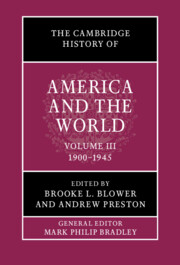Book contents
- The Cambridge History of America and the World
- The Cambridge History of America and the World
- The Cambridge History of America and the World
- Copyright page
- Contents
- Figures
- Maps
- Contributors to Volume III
- General Introduction: What is America and the World?
- Introduction to Volume III
- Part I American Power in the Modern Era
- 1 The Sinews of Globalization
- 2 The Territorial Empire
- 3 Waging World War I
- 4 Technological Transformations
- 5 Law and American Power
- 6 Latin America and US Global Governance
- 7 Transatlantic Relations
- 8 The Open Door, Tsarist Russia, and the Soviet Union
- 9 The Rise of the Modern Middle East
- 10 Competing Empires in Asia
- 11 Making a Modern Military
- Part II Competing Perspectives
- Part III The Perils of Interdependence
- Index
6 - Latin America and US Global Governance
from Part I - American Power in the Modern Era
Published online by Cambridge University Press: 12 November 2021
- The Cambridge History of America and the World
- The Cambridge History of America and the World
- The Cambridge History of America and the World
- Copyright page
- Contents
- Figures
- Maps
- Contributors to Volume III
- General Introduction: What is America and the World?
- Introduction to Volume III
- Part I American Power in the Modern Era
- 1 The Sinews of Globalization
- 2 The Territorial Empire
- 3 Waging World War I
- 4 Technological Transformations
- 5 Law and American Power
- 6 Latin America and US Global Governance
- 7 Transatlantic Relations
- 8 The Open Door, Tsarist Russia, and the Soviet Union
- 9 The Rise of the Modern Middle East
- 10 Competing Empires in Asia
- 11 Making a Modern Military
- Part II Competing Perspectives
- Part III The Perils of Interdependence
- Index
Summary
Many standard practices of US foreign policy around the globe today were forged in Latin America before the United States became a global superpower. It was in Latin America that the United States first trained sovereign military forces, used development as a counterinsurgency technique, experimented with cultural diplomacy, led in the creation of an international governmental organization, and signed a regional security pact. But Latin America was not a sterile laboratory for the unilateral development of US foreign policy. Rather, policymakers crafted these various strategies for advancing US interests in response to Latin American engagements with US power and changing political circumstances.
- Type
- Chapter
- Information
- The Cambridge History of America and the World , pp. 153 - 173Publisher: Cambridge University PressPrint publication year: 2022

